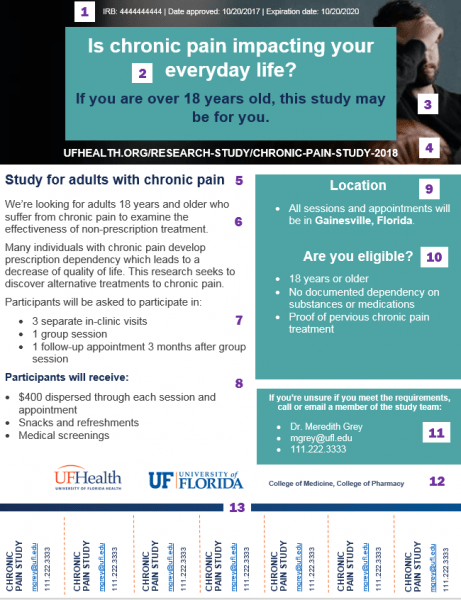The flyer below uses best practices with the Recruitment Center template. Each number on the flyer image corresponds with an explanation of why strategies (e.g., text, photos and graphics) were used and what makes them effective

1
Headlines
This headline speaks to the target audience (chronic pain sufferers) and includes eligibility criteria.
2
Images
Choose a relevant, high-quality photo that represents your target audience.
3
UFHealth.org study listings
Your audience can find more information on a study web page. Add your listing on high-traffic UFHealth.org at no cost.
4
Details
Summarize the study name. Think about how you describe your study on your informed consent.
5
Easy to read
Write study details in an easy-to-understand way, as if you were talking to your neighbor.
6
Expectations
Clearly state what participants can expect. Use bulleted lists where possible, as dense blocks of text can be difficult to read.
7
Compensation
Many participants are motivated by compensation. (This text must appear in the same size as the rest of the flyer.)
8
Location
Include the address and a brief description. If the study is on campus, include information about parking or public transportation.
9
Describe requirements
Save time for your team and participants by clearly describing requirements, and provide an email or phone for questions.
10
Contact info
Be sure contact information is accurate and offer multiple channels (e.g. email address, phone number, website).
11
Using logos
Your logo usage will depend on funding.
12
Tear-offs
User testing on these templates demonstrated that tear-offs on flyers are preferred.
Best practices checklist
Stand out with an effective headline
User testing has shown that this is the most important part of the flyer. Headlines should:
- Catch the attention of your target audience. If your flyer is hanging on a wall among dozens of others, what would make it stand out?
- Avoid generic language such as, “Research study seeking participants”
- Clearly state the purpose of the research study. For example: “Is your current antidepressant not helping your mood?” “Do you have asthma?” “Have you given birth in the past 6 months?”
Include mandatory IRB details
The templates include room for the mandatory details as designated by the IRB:
- Condensed study title
- Purpose of the study
- Protocol summary
- Basic eligibility criteria
- Study site location(s)
- How to contact the study site for more information
Include these mandatory details in as succinct a fashion as possible (see example templates). By including these details, you ensure individuals are contacting you because (1) they qualify for the study and (2) they have enough information to make an informed decision about deciding to participate. This saves time for both the researcher and the potential participant.
Tailor your message to your audience
Keep it simple and concise. Many people find it difficult to retain a lot of written information.
- Did you know that participants are interested in research studies that are beneficial to their communities? Think about how your study will benefit the people you are trying to recruit and include that information on your recruitment materials. Unsure of the benefits? Consider including members of the community or your target population in study planning and development of recruitment materials.
- Did you know that the average reading level in Alachua County is middle school, and that people who cannot comprehend the information presented in recruitment are less likely to participate in clinical studies? Consider how you would explain your study to a neighbor, and make sure the information on the flyer passes the “small-talk test.”
You can use these tools to help write participant-friendly recruitment messages:
- Medline Plus offers guidelines and resources to help you create easy-to-read health materials.
- University of Michigan Plain Language Dictionary: Enter medical terms and view alternative phrasing to simplify the description.
Select an engaging image
Photos and images can draw more interest from potential participants. Make sure images are:
- Relevant to your study and represent your target audience (e.g., includes older adults if recruiting for an aging study)
- High-quality (i.e., large file size that will display well, not pixelated, in print). Image should be at least 600 x 600 pixels.
- Yours to use on the flyer (i.e. you created the image and have permission from photo subjects, or you have rights to use a photo that you did not take, and you properly credit the image according to terms of use)
You can find FREE stock photos on these websites:
- UF Health Photoshelter
- UF Photoshelter
- https://www.pexels.com/
- https://stocksnap.io/
- https://unsplash.com/
- https://burst.shopify.com/
- Need more? You can find a whole list here: https://blog.snappa.com/free-stock-photos/
Format your content
Format matters, especially to readability: The text boxes within the templates are sized for maximum effectiveness. Keep it simple and concise!
- Having trouble fitting all of your information on the flyer? Try condensing the content.
- Use bulleted lists to break up content and optimize readability
- Do not adjust the margins to fit more content
- Do not decrease the font below 10 points
Use the correct branding and logo
When do you use the UF brand vs. the UF Health brand? That depends. UF Health brand and logo
- Use if you are funded by UF Health or are using UF Health services for your research.
- You will need to use the UF Health specific templates.
- Review specific UF Health guidelines for the UF Health logo.
UF brand and logo
- Use if you are funded by a college, university-designated center or institute
- You will need to use the UF specific templates.
- See guidelines for UF logo use on the UF Brand Center site
- Do not clutter your flyer with multiple logos. If you are a part of the College of Medicine, use the main UF logo and type “College of Medicine” in plain text on the flyer (example below)


